Every day or so I tiptoed to the edge of the bushland to spy on a Grey Fantail nest. I tucked myself amongst the Swamp Paperbark and watched the parent birds binding the fine grasses of their nest with bills full of cobwebs. The nest is 2 metres above ground, snuggly attached to the fork of a tree, with a tapering stem that gives it a wine glass shape and helps disguise it as a bundle of vegetation caught on a branch.
I stayed well away from the nest while the eggs were being incubated. After a couple of weeks I looked again, from a distance, and saw a soft mound of feathers peeking over the rim of the nest.
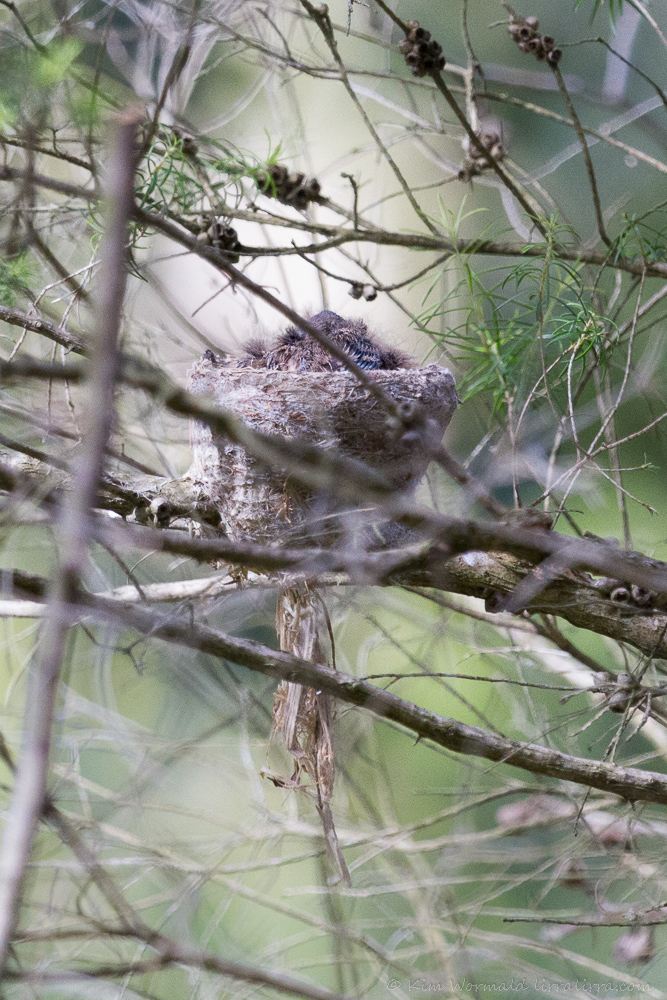 Grey Fantail (Rhipidura albiscapa)
Grey Fantail (Rhipidura albiscapa)
Canon 7D, 100-400mm L IS USM, 1/250, f/5.6, ISO 1600 (set as max), monopod
(heavily cropped)
The conditions were not ideal for photography as the subject was small, the lighting was poor and the scene was cluttered with branches but I believe whole-heartedly in the bird photography code of ethics and was extremely vigilant about not disturbing the nest, not causing the birds any anxiety and not using a flash. I was able to get close enough to take images as the nest is in my garden and the resident fantails are familiar with me roaming around. It’s along a pathway that usually gets a lot of use but which I didn’t use at all for a month. The moment I noticed the beginnings of the nest I kept away, only looking at the nest through binoculars or using the 100-400mm lens. Nesting birds are extremely vulnerable and ensuring their safety and well-being was my top priority.
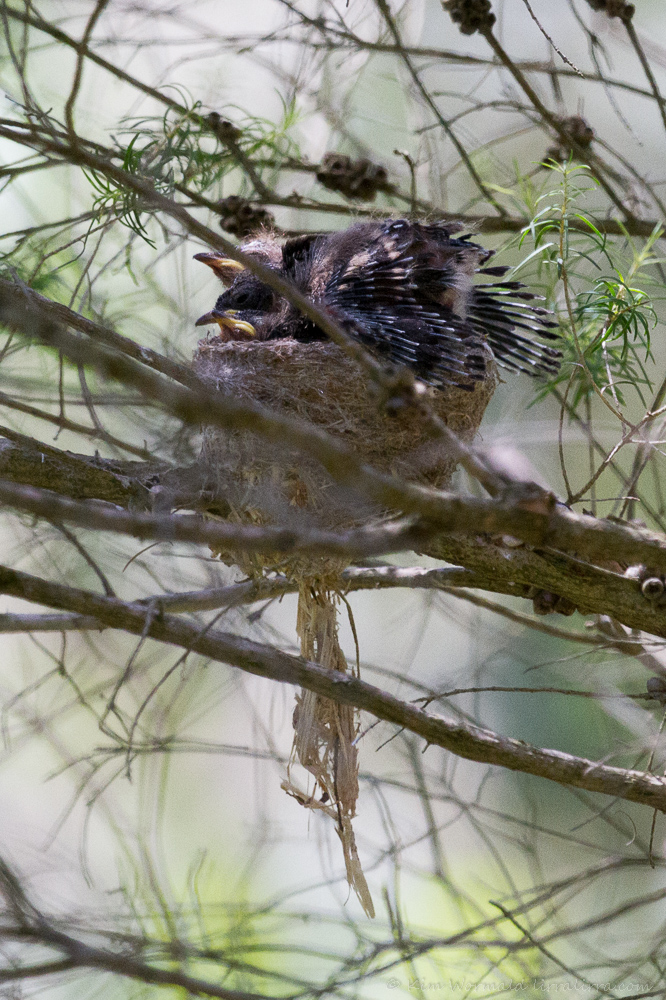 Grey Fantail
Grey Fantail
Canon 7D, 100-400mm L IS USM, 1/400, f/6.3, ISO 1600, exposure compensation 1/3, monopod
(heavily cropped)
The nestlings occasionally stretched their wings, an activity which increased in frequency as they developed. The image above shows the emerging feathers, called pin feathers, which grow from a follicle in the skin. The shiny sheaths covering each feather are clear in this image. The nestlings remove the sheaths by preening as their feathers grow.
I visited every day or so, only staying for a few moments each time. The parent birds visited every few minutes to transfer bugs of all kinds to the waiting nestlings. Each transfer of food lasted only a second or two. The monopod was ideal as without it I would have been holding the camera ready for each shot and I’m sure the parent birds would have arrived the moment I took a rest. I experimented by taking images at different times of the day with different depths of field and levels of exposure compensation. I increased the exposure during post-processing.
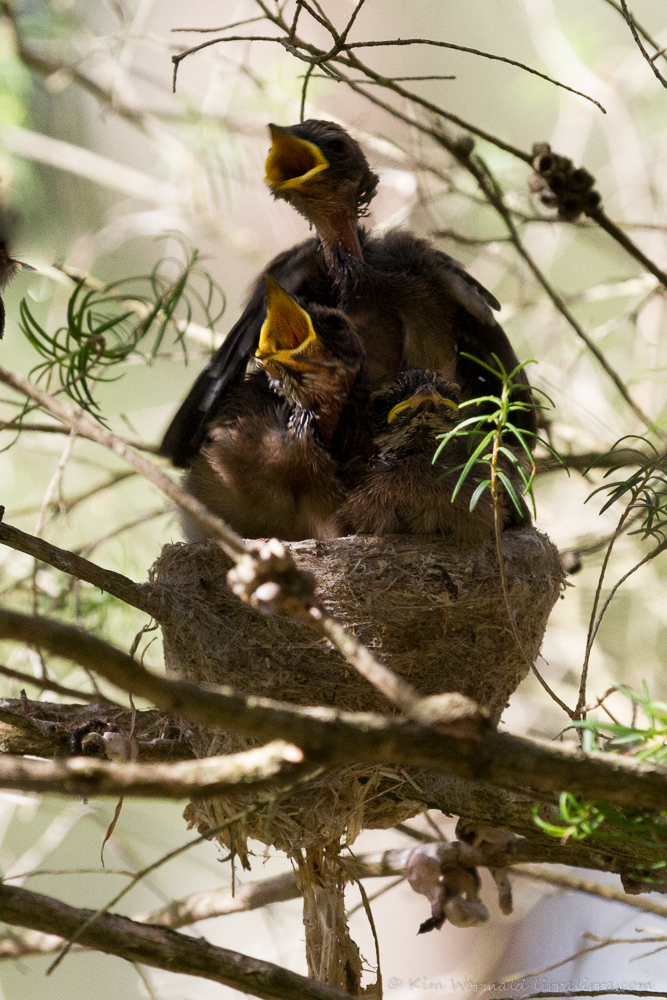 Grey Fantail nestlings
Grey Fantail nestlings
Canon 7D, 100-400mm L IS USM, 1/320, f/8, ISO 1600, exposure compensation 1/3, monopod
(heavily cropped)
The nestlings stayed still until a parent arrived when they would perk up, quivering as they begged. The image above shows a hint of the flurry of movement that punctuated the lulls.
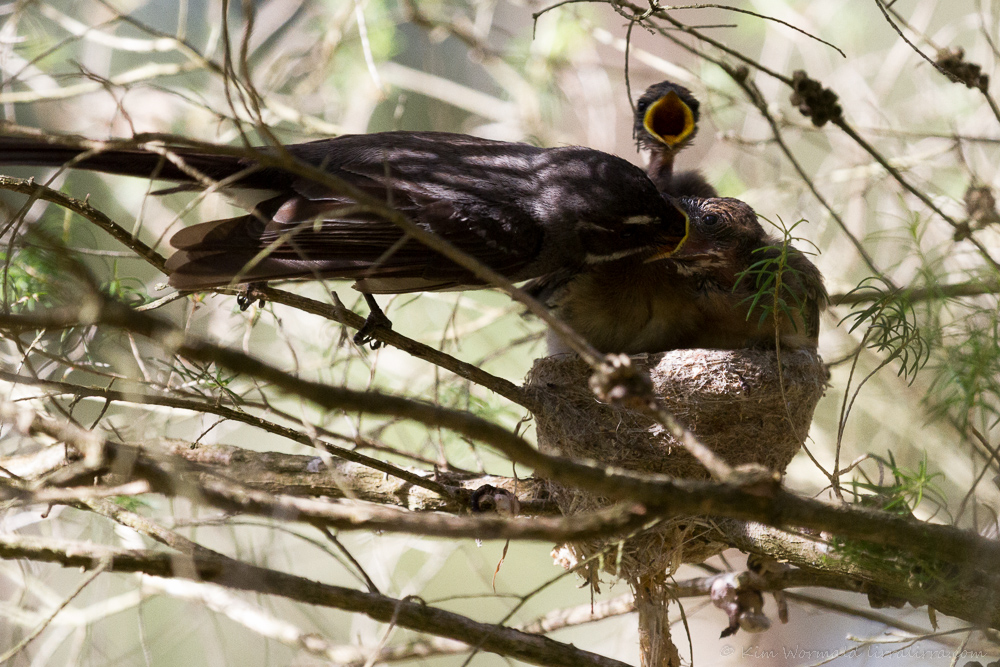 Grey Fantail
Grey Fantail
Canon 7D, 100-400mm L IS USM, 1/400, f/7.1, ISO 1600, exposure compensation 1/3, monopod
(heavily cropped)
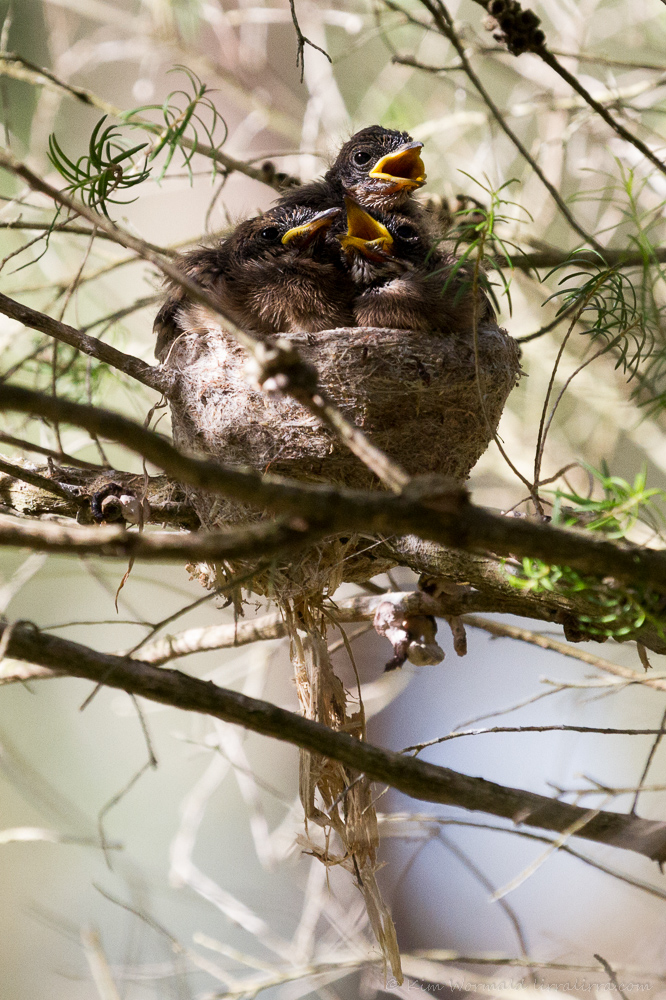 Grey Fantail
Grey Fantail
Canon 7D, 100-400mm L IS USM, 1/400, f/8, ISO 1600, exposure compensation 1/3, monopod
(heavily cropped)
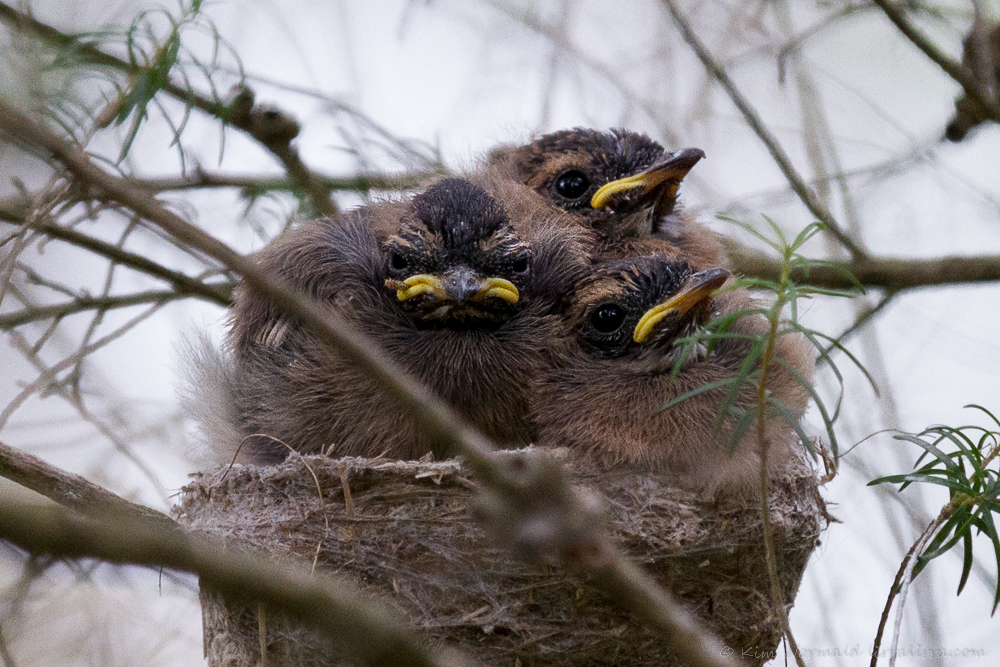 Grey Fantail
Grey Fantail
Canon 7D, 100-400mm L IS USM, 1/250, f/6.3, ISO 1600, exposure compensation 1/3, monopod
(heavily cropped)
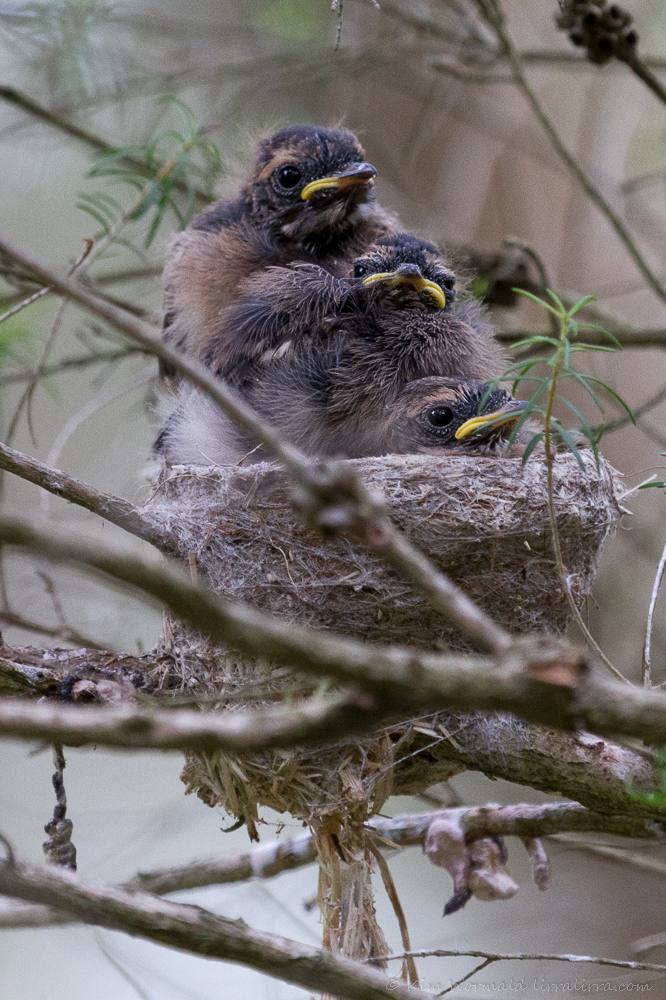 Grey Fantail
Grey Fantail
Canon 7D, 100-400mm L IS USM, 1/200, f/7.1, ISO 1600, exposure compensation 1/3, monopod
(heavily cropped)
 Grey Fantail
Grey Fantail
Canon 7D, 100-400mm L IS USM, 1/250, f/7.1, ISO 1600, exposure compensation 1/3, monopod
(heavily cropped)
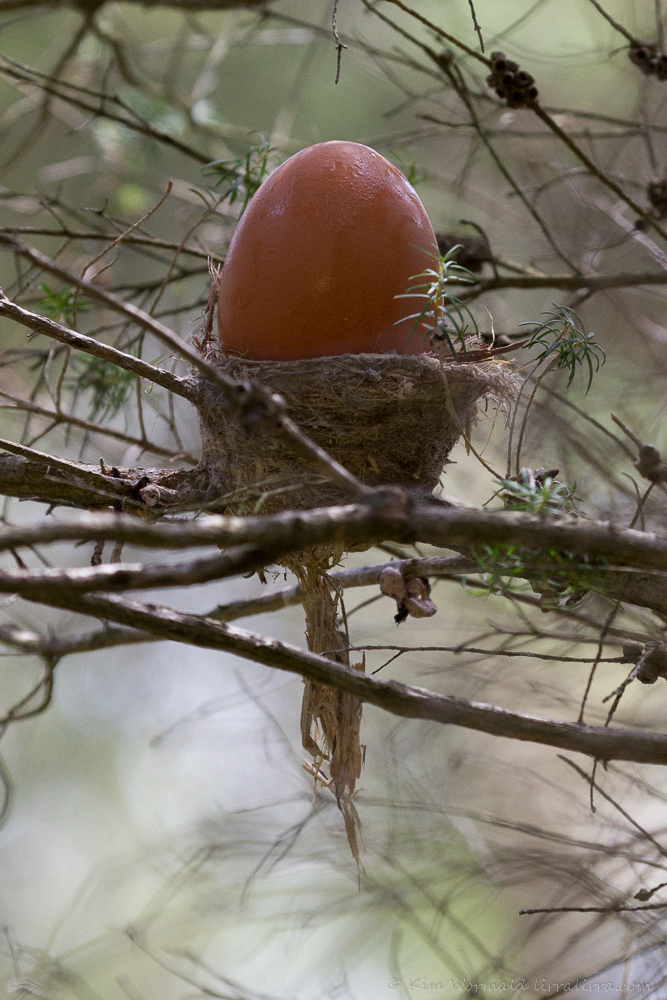 Grey Fantail nest with hen’s egg
Grey Fantail nest with hen’s egg
Canon 7D, 100-400mm L IS USM, 1/250, f/7.1, ISO 1600, exposure compensation 1/3, focal length 370mm, monopod
After only looking at the nest through my camera or binoculars for a month it was lovely to take a closer look when the fantail babies had left. I wondered how I could best show the size of the nest and decided to take an egg from my fridge, even I was surprised by how snugly it fit.
I wondered about sharing these images because I would hate anyone to think they could have been taken without a long lens and then heavily cropped. NESTS SHOULD NEVER BE APPROACHED – parent birds are likely to abandon a nest if they are disturbed and predators can be attracted to nesting sites by the presence or smell of humans. Even though I vistited rarely and stayed well away from the nest I left the area completely if I heard ravens or butcherbirds calling. Since taking these images I have seen the fledglings being fed in other parts of the garden and I look forward to the next generation of Grey Fantails swooping around my head to catch flying insects as I walk around the paddocks.
Happy birding, Kim

We are delightfully surprised to find that grey fantails have made a nest in our Elm Tree directly outside our front door at head height! It is a very busy thoroughfare but we are very careful to not stress them. They don’t seem to mind us walking past them though.
We watch them coming and going on our verandah where they can’t really see us. They’re fascinating to watch coming and going and taking turns minding the babies. We even watched them attacking a butcher bird that got too close one day! It’s a privilege to have them in our garden. I am enjoying them immensely
That sounds seriously wonderful Maree! Good on them for attacking the butcherbird. I photographed a juvenile fantail here today, I really love their rufous colours when they are young. One of my favourite photographs is of a young fantail in beautiful light with its tail spread out, it’s hanging on the wall beside me. I hope your little nestlings fledge successfully and bring you much pleasure, Kim
… in the degree to which they are frightened by human contact. Fantails seem to be known for being very inquisitive of humans and human activities, as are the spectacular fairy wrens we have the joy of watching. In fact our recent experience is that they seem to seek out our company (the fantails) while we potter about in the garden. What a joy they are!
Lee
That is awesome Lee! I do agree that some birds are comfortable with some humans, and fantails and robins often like to follow us around to feast on the insects we disturb as we walk/work. I enjoy the updates about your little fantail family
Well, we’re waiting patiently and checking several times through the day to see who’s on the eggs. The other day when I didn’t see either bird on the nest I watched for longer, expecting one to return soon. When nothing happened, I went outside and checked the nest quickly with a long-armed mirror and saw there were three eggs and then got back inside just before mama re-appeared. Another few days and there might be baby pictures. Lee
My wife and I have been greatly entertained by watching a pair of fantails construct their nest over a couple of weeks. Since earlier this week they’ve been incubating a clutch. We are fortunate that they chose to make their nest where it can be seen (and photographed) through an open window. So, discovering your beautiful photographs has given us much to look forward to – thanks and congratulations.
While endorsing your stress on ethical observation and photography, it’s also important to recognise that birds (probably all animals, really) vary by kind
Hi Kim,
I discovered these nests attached to south facing camellia trees the last two summers. I assumed the architect was one of the species of wrens or finches that are prolific in my garden. A couple of weeks ago a grey fantail was consistently ‘attacking’ webs the north facing window corners until most had disappeared. Last week I was washing dishes and a movement in one of the camellias directly outside the window caught my eye. The fantail was building!
Obviously I’m trusted as I pass within a metre to the clothesline and also cutting grass on the lawn tractor! So thanks for the great photos and hopefully I’ll get to see the real thing.
What a wonderful story Margaret. When I was watching this nest with binoculars I was surprised to see how agitated the birds became when the brush-cutter was being used (it is regularly used in the garden). I decided it must be because the birds can’t just fly away from the sound as they usually would. Your fantails might not have been in the camellia when the tractor was going by so it could be good to make sure it’s not stressful for them, or maybe not mow until the babies have fledged. I’d love to hear how the nest goes, it’s so perfect to have it outside of your window, what a delightful honour!
These photos and stories about grey fantails being raised is delightul.
Brought huge smiles to my face. Thankyou so much.
Such talented photography!
Thank you Kathryn, I’m pleased they made you smile.
Beautiful photos, Kim and a lovely story to complete the picture.
Thank you Carole
[…] Fantail nest – please view Grey Fantails in an egg cupfor more images and comments on the importance of nest photography […]
[…] fill their nest. The fantails on natural perches are quite possibly the birds that featured in Grey Fantails in an Egg Cup, clicking the link will take you to the […]
Thank you for your descriptive and informative story and photo journal of the grey fantail nestlings. I couldn’t picture the fantail nest based on the verbal descriptions I read; your pictures of the nest have filled the mental gap.
There is a lone grey fantail that often visits my garden, announcing its arrival with a volley of sharp chirps and vigorously wagging and fanning its tail so it with great interest that I read your story which gives me an insight into the bird’s breeding cycle that I am yet to have.
Many, many thanks.
Hi Melanie, I am so pleased that you enjoyed the information and images of the fantails raising their chicks. Hopefully next spring we’ll both have fantails nesting in our gardens
Wow amazing images. I agree with Mia very much. It is particularly useful information for people who may otherwise inadvertantly endanger fledglings.
Thanks Lannie, I’m very conscious of bird photography ethics, it has to be the birds’ wellbeing first and I’m really pleased that so many people understand that.
Love the photos, such a tiny little nest.
I’m glad you like the photos. It was hard for me to believe the size of the nest as I was always looking at it through binoculars or the big lens. How on earth did they all fit in there without falling out!
[…] Older Entries » Fan-tailed Cuckoo Along with the springtime flurry of baby birds, like the Grey Fantail nestlings in last week’s post, comes the springtime arrival of cuckoos. Shining Bronze, […]
These photos are the begiinings of a lirralirra calendar I think. Beautiful !
Hi Diane, are you telepathic? I was up until 3:30am working on a calendar and got back to work straight after breakfast! I’m really glad you like the images
Kim,
I’m so very glad that you expressed your strong ethics regarding nest photography. Thank you for doing that, the more people that write about the more the general public will gain knowledge about it.
I love how the images show the growth of the chicks and how snug that nest is with a hen’s egg in it.
Hi Mia, let me know if there is anything I missed re the ethics of nest photography. I’m glad you enjoyed the images, there are miracles all around us.
It was brilliant!
The egg in the nest is so damn cute! Love little grey fantails! So pretty! lovely pictures!
lovely pictures!
They are lovely little birds, I agree. So glad you liked the photos and the egg in the nest